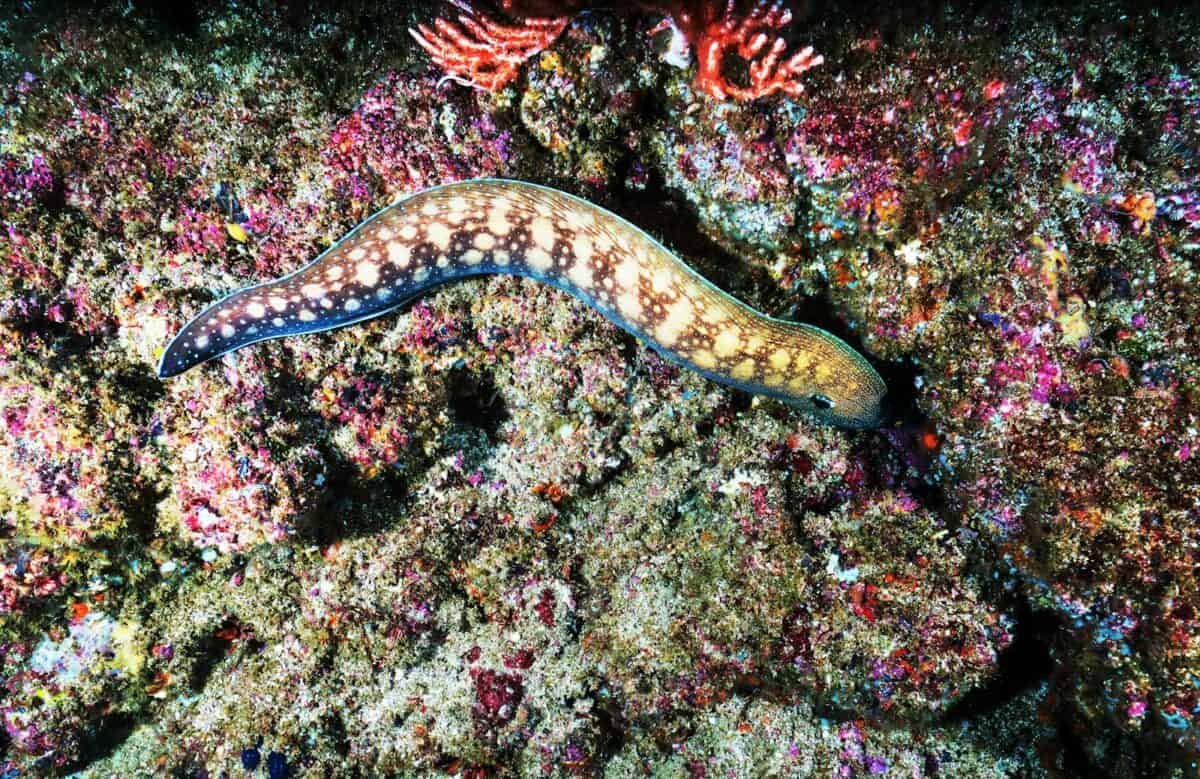Deep in the murky waters of South America’s Amazon and Orinoco basins, a remarkable creature has evolved one of nature’s most sophisticated electrical systems. The electric eel—not actually an eel but a knifefish—possesses the extraordinary ability to generate powerful electrical discharges that serve dual purposes: hunting prey and navigating its environment. These living batteries can produce charges of up to 860 volts, making them one of the most electrically potent animals on Earth. Through millions of years of evolution, electric eels have developed specialized organs that account for approximately 80% of their body mass, dedicated solely to electricity production. This biological marvel represents one of nature’s most fascinating adaptations, allowing these creatures to thrive in environments where visibility is poor and conventional hunting strategies would fail. Let’s dive deeper into the electrifying world of these remarkable aquatic predators.
The Biology Behind the Shock

Electric eels (Electrophorus electricus and related species) possess three specialized electric organs—the main organ, Hunter’s organ, and Sachs’ organ—comprising modified muscle cells called electrocytes. Unlike regular muscle cells that contract, electrocytes are stacked in series like batteries, creating a voltage gradient across the eel’s body. When activated, these cells simultaneously release positively charged ions, generating an electrical current that flows through the water.
The main electric organ runs along most of the eel’s body length and produces high-voltage discharges, while the Sachs’ organ generates lower-voltage pulses used for navigation and sensing. This biological electricity generator represents one of the most remarkable examples of convergent evolution, as electric organs have evolved independently in several fish lineages. The electrocytes are controlled by the eel’s nervous system, allowing precise control over the timing and intensity of electrical discharges.
Types of Electrical Discharges

Electric eels produce three distinct types of electrical discharges, each serving a specific function in their hunting and navigation strategies. Low-voltage pulses (around 10 volts) are emitted continuously at rates of 1-5 Hz while the eel is awake, functioning like a biological radar system for navigation and environmental sensing. Medium-voltage discharges (around 100 volts) occur in pairs or triplets at higher frequencies (30-60 Hz) and are typically used during active hunting to locate prey.
High-voltage discharges (500-860 volts) are reserved for stunning prey and self-defense, occurring in bursts of 400-500 Hz lasting about 2 milliseconds. Research has shown that eels can modulate these discharges with remarkable precision, adjusting the intensity and frequency based on the situation. This sophisticated electrical arsenal allows electric eels to thrive in their challenging aquatic environments, where visibility is often severely limited.
Electroreception: The Sixth Sense

Electric eels possess an extraordinary sensory system called electroreception that allows them to detect and interpret electrical fields in their environment. Their bodies are covered with electroreceptors—specialized sensory organs that can detect even the faintest electrical signals produced by other organisms or environmental features. When the eel emits low-voltage pulses, these create an electrical field around its body. Any objects or creatures in this field distort the electrical pattern, and these distortions are detected by the eel’s electroreceptors.
This system functions effectively as a biological sonar, providing the eel with a detailed electrical “image” of its surroundings. Remarkably, electric eels can detect prey hiding in mud or sand, distinguish between animate and inanimate objects, and even assess the size and type of nearby organisms through this electrosensory system. In the murky waters where visibility may be limited to just a few centimeters, electroreception provides electric eels with a critical advantage, allowing them to navigate and hunt efficiently where visual predators would struggle.
The High-Voltage Hunting Strategy

When hunting, electric eels employ a sophisticated strategy that leverages their powerful electrical discharges. Upon detecting potential prey through electroreception, the eel first uses medium-voltage pulses to confirm the target’s location. Once a prey item is identified, the eel delivers a rapid burst of high-voltage discharges that serves multiple purposes. These powerful shocks cause involuntary muscle contractions in nearby prey through a process called electrotaxis, effectively immobilizing the target. Research has shown that these discharges simultaneously overload the prey’s nervous system, preventing escape.
Perhaps most impressively, the electrical discharge creates a “remote control” effect, causing nearby fish to twitch involuntarily, revealing their exact location to the eel. This hunting technique is remarkably efficient in the turbid waters where electric eels reside, allowing them to capture prey with precision despite poor visibility. The eel can then approach the immobilized prey and consume it whole, typically without needing to deliver additional shocks.
The “Doubletap” Hunting Technique

Scientists have discovered that electric eels employ a sophisticated hunting technique known as the “doubletap.” This strategy involves the eel delivering two rapid high-voltage discharges separated by a brief pause of about 0.1 seconds. The first discharge causes prey fish to freeze due to involuntary muscle contractions. During the momentary pause, the prey’s muscles begin to relax, often causing it to twitch or move slightly. This minor movement creates additional electrical signals that the eel can detect, essentially revealing the prey’s exact location.
The eel then delivers a second, precisely targeted discharge to immobilize the prey completely before approaching to consume it. This doubletap technique demonstrates the remarkable sophistication of the electric eel’s hunting strategy, combining both offensive and sensory applications of its electrical abilities. Research published in Current Biology revealed that this hunting method significantly increases the eel’s hunting success rate, particularly in environments with limited visibility where visual tracking of prey would be impossible.
The “Volt-Face” Maneuver

One of the most remarkable hunting behaviors of electric eels is the “volt-face” maneuver, first documented by researchers in 2015. When confronted with large or particularly evasive prey, electric eels execute a specialized attack where they quickly curl their body into a C-shape, bringing their head close to their tail while the prey is positioned in the middle. This posture doubles the electrical field strength by concentrating the current through a smaller area of water, effectively doubling the voltage experienced by the prey.
During this maneuver, the eel traps the prey between the positive and negative poles of its biological battery, maximizing the shock’s effectiveness. High-speed video analysis has shown that eels can perform this complex maneuver in less than 100 milliseconds, demonstrating extraordinary neuromuscular coordination. The volt-face technique is particularly employed against larger, more resistant prey that might survive a standard electrical discharge. This behavior represents one of the most sophisticated electrical attack strategies in the animal kingdom and showcases the remarkable evolutionary adaptations of electric eels.
Navigating Through Electricity

Electric eels use their electrical abilities not just for hunting but also as a sophisticated navigation system in their murky habitat. By continuously emitting low-voltage pulses, electric eels create an electrical field that extends approximately one body length around them. This field acts like a bubble of sensory information, with any object entering this space causing distortions in the electrical field that the eel can detect through its electroreceptors. These distortions provide the eel with detailed information about the object’s size, composition, and movement.
Studies have shown that electric eels can distinguish between conductive and non-conductive objects, effectively differentiating between potential prey and inanimate obstacles. This electrical navigation system allows eels to build a detailed three-dimensional map of their surroundings, helping them navigate through complex underwater environments even in complete darkness or extremely turbid water. Additionally, this system helps them locate suitable hiding places, avoid predators, and find optimal routes through their habitat. The continuous nature of this electrical sensing ensures the eel maintains constant awareness of its environment, compensating for its relatively poor eyesight.
The Air-Breathing Connection

An intriguing aspect of electric eel biology is the relationship between their electrical abilities and air-breathing behavior. Unlike many fish, electric eels are obligate air-breathers, meaning they must periodically rise to the surface to gulp air, which they absorb through a specialized vascularized mouth lining. This air-breathing adaptation is closely connected to their electrical capabilities. The intense energy demands of generating electrical discharges require substantial oxygen, more than could be extracted from the oxygen-poor waters where they live.
Research has shown that after periods of intense electrical activity, eels increase their air-breathing frequency to replenish oxygen levels. This connection between respiration and electrical generation creates a unique vulnerability—electric eels must periodically expose themselves at the surface. However, they’ve evolved to mitigate this risk by taking extremely quick breaths, typically completing the surface visit in less than a second. This air-breathing requirement also explains why electric eels are sometimes observed in shallow waters or even briefly traversing land between pools—behaviors that might seem counterintuitive for an aquatic predator but make sense considering their respiratory needs.
Communication and Social Behavior

While often portrayed as solitary hunters, electric eels display more complex social behaviors than previously recognized, with electricity playing a central role in their communication. During breeding seasons, male electric eels produce distinct patterns of electrical discharges that differ from their hunting or navigation pulses. These specialized signals appear to serve as mating calls to attract females and potentially to establish dominance hierarchies among competing males. Research conducted in the Amazon basin has documented groups of electric eels coordinating their hunting activities, with multiple individuals surrounding schools of smaller fish and simultaneously delivering synchronized electrical discharges.
This cooperative hunting strategy substantially increases their collective success rate. Additionally, juvenile electric eels often remain together in groups, producing synchronized electrical discharges that may serve both defensive purposes and help them coordinate movements. Interestingly, electric eels can recognize the electrical signatures of conspecifics versus other species, allowing them to identify potential mates or rivals. This sophisticated electrical communication system represents one of the most specialized forms of communication in the aquatic world.
Dealing with Larger Threats

Electric eels have developed remarkable defensive strategies against larger predators, utilizing their electrical abilities in ways that go beyond simple shocking. When threatened, an electric eel can leap partially out of the water while pressing its chin against a potential threat, delivering a concentrated electrical discharge directly to the predator. This behavior, documented by researchers studying the interaction between electric eels and alligators, allows the eel to bypass the water’s dispersive effect on electricity, delivering a more powerful shock directly to the threat.
Another defensive adaptation involves the production of rapid, high-frequency volleys of electrical discharges that can cause painful muscle contractions in predators, deterring further aggression. Research has shown that these defensive discharges are typically of higher voltage and longer duration than those used for hunting, indicating a specialized defensive electrical pattern. Perhaps most impressively, when truly threatened, electric eels can continue delivering powerful shocks for up to an hour without significant fatigue, creating an effective deterrent against even the most persistent predators. These sophisticated defensive mechanisms have allowed electric eels to thrive despite sharing habitats with numerous predatory species.
Evolution of Electric Organs

The evolution of electric organs in eels represents one of the most fascinating examples of adaptation in vertebrate history. Genetic and developmental studies reveal that electric organs evolved from muscle tissue, with specific genetic mutations transforming what would have become locomotory muscles into specialized electricity-generating cells. This evolutionary transformation involved the loss of contractile proteins in muscle cells and the proliferation of voltage-gated sodium channels, essentially converting motion-producing cells into electricity-producing ones.
Comparative genomic analyses across weakly electric fish and strongly electric species like the electric eel have identified several key genes involved in this transformation, including the duplication and modification of the Nav1.4a sodium channel gene. Remarkably, electric organs have evolved independently at least six times across different fish lineages, representing a striking example of convergent evolution. Fossil evidence suggests electric organs first appeared approximately 150-200 million years ago, with the modern electric eel’s high-voltage system representing the most powerful and specialized version of this adaptation. This evolutionary innovation provided these species with a unique ecological niche, allowing them to thrive in environments where visual predation would be ineffective.
Recent Discoveries and Species Diversity

Until recently, scientists believed there was only one species of electric eel (Electrophorus electricus). However, groundbreaking research published in 2019 revealed that electric eels actually comprise three distinct species: E. electricus, E. varii, and E. voltai. This taxonomic revision came after detailed genetic analysis and examination of specimens across the Amazon basin. E. voltai, found in the highland waters of the Brazilian Shield, can generate the strongest electrical discharge of any known animal—up to 860 volts, significantly higher than the 650 volts previously recorded as the maximum.
Each species has adapted to slightly different ecological niches, with variations in their electrical organs reflecting adaptations to specific environmental conditions. Beyond these new species discoveries, researchers have also documented previously unknown behaviors, including evidence that electric eels can coordinate their hunting in groups, with multiple individuals surrounding prey and delivering synchronized electrical attacks. Additionally, sophisticated imaging techniques have revealed more details about how electrical discharges propagate through water, showing that the eel can focus its electrical field with remarkable precision. These recent discoveries highlight how much remains to be learned about these fascinating creatures, despite centuries of scientific interest.
The Electrifying Future of Research

The unique biological electricity-generating capabilities of electric eels continue to inspire cutting-edge scientific research across multiple disciplines. Biomedical engineers are studying electric eel cells as models for developing self-charging batteries and power sources for medical implants like pacemakers and neural stimulators. The genes responsible for the development of electrocytes are being investigated for potential applications in regenerative medicine, particularly for conditions involving muscle dysfunction. Neurobiologists are examining how electric eels process the complex electrical information they receive, providing insights into signal processing that could inform artificial intelligence development.
Environmental scientists are now using environmental DNA techniques to track electric eel populations without direct capture, allowing for more comprehensive ecological studies. As climate change and deforestation increasingly threaten the Amazon basin, understanding these remarkable creatures has taken on new urgency. Future research directions include investigating how electric eels might be affected by increasing water temperatures, pollution, and habitat fragmentation. The electric eel remains not just a biological marvel but an important research subject that continues to generate valuable scientific insights with applications far beyond ichthyology.
Conclusion

Electric eels represent one of nature’s most remarkable evolutionary achievements, having transformed muscle tissue into sophisticated bioelectrical organs capable of generating both high-voltage weapons and sensitive detection systems. Their multifaceted use of electricity for hunting, navigation, communication, and defense showcases how a single adaptation can evolve into a complex suite of behaviors that define a species’ ecological niche. As we’ve discovered, these creatures are far more sophisticated than once believed—employing tactical hunting maneuvers, coordinating group attacks, and possessing communication systems that we are only beginning to understand.
The recent discovery that electric eels comprise multiple species, each with unique adaptations to their specific habitats, reminds us that biodiversity often exceeds our initial classifications, especially in understudied ecosystems like the Amazon basin. As these remarkable creatures continue to inspire scientific research across disciplines from neurobiology to biomedical engineering, they serve as powerful reminders of nature’s ingenuity and the importance of preserving the complex ecosystems where such evolutionary marvels continue to thrive.
- This Fish Has the Most Teeth in the Ocean—And Uses Them Well - August 9, 2025
- How Wolves Use Group Howls to Reunite With Pups - August 9, 2025
- 12 Dog Breeds That Form the Deepest Emotional Bonds with Their Owners - August 9, 2025

